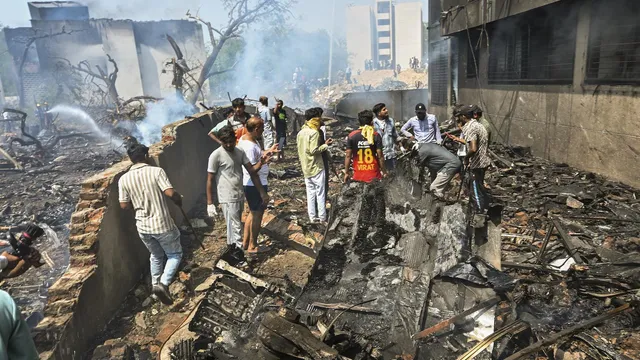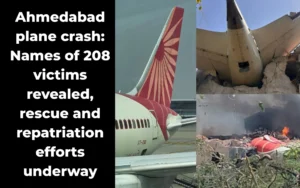The tragic accident of Air India flight AI-171 in Ahmedabad on June 12, 2025 is being investigated with utmost seriousness by the Indian authorities. The accident claimed the lives of 241 of the 242 people on board the London-bound Boeing 787-8 Dreamliner aircraft, and many more died on the ground after it collided with the hostel building of B.J. Medical College, taking the total death toll to around 280. The accident has become one of the deadliest incidents in modern aviation history and is the first fatal accident of a Boeing Dreamliner.
Immediate cause of the accident and initial findings:
The horrific accident occurred seconds after the plane took off. According to initial reports and eyewitness statements, the plane started losing altitude soon after take-off. The crew of the plane had issued a “mayday” call, reporting “loss of thrust” and “inability to fly”. Initial findings from the investigation also revealed that the plane’s emergency power system, called the Ram Air Turbine (RAT), had activated just before the crash.
The RAT is a small turbine that is deployed to power the plane in an emergency, especially when both engines fail or hydraulic pressure is lost. Experts believe that the activation of the RAT could be a sign of dual engine failure or complete electrical failure, however, dual engine failure is considered extremely rare in modern aircraft.
However, investigators have not yet been able to confirm what caused the RAT to activate – an engine malfunction, a hydraulic problem, or another technical fault. The plane’s wings and control surfaces were properly configured for take-off, which supports the view that the accident occurred shortly after take-off.
Status and analysis of black boxes
Two sets of Digital Flight Data Recorder (DFDR) and Cockpit Voice Recorder (CVR) have been recovered from the crash site. Both of these are collectively called Enhanced Airborne Flight Recorder (EAFR). The first black box was recovered on June 13 and the second on June 16. The black boxes provide crucial data to reconstruct the final moments of the crash. The DFDR records flight parameters such as altitude, speed, engine thrust, while the CVR captures crew conversations, warning alerts and other sounds in the cockpit.
Initially, there were reports that the black boxes would be sent abroad for analysis as India does not have advanced technology to extract data from the black boxes of this Boeing aircraft. However, the Ministry of Civil Aviation (MoCA) has denied these reports, saying that the black boxes are being analysed at the Ministry of Civil Aviation’s “Black Box Lab” in India. The lab is designed to repair the damaged flight recorder, retrieve crucial data and correlate findings from multiple sources. The ministry has also said that the final decision about the location to decode the black boxes will be taken by the Aircraft Accident Investigation Bureau (AAIB) after assessing all technical, safety and security considerations. They may be sent abroad if required and the technology is not available in India. Experts from the US National Transportation Safety Board (NTSB) and Original Equipment Manufacturers (OEMs) are also assisting the AAIB in its investigation, which is in line with International Civil Aviation Organisation (ICAO) protocols.
Victims and sole survivor
Of the 242 people on board the plane, only one passenger, British national Vishwas Ramesh, survived the horrific accident. He was seated on seat 11A, which was next to an emergency exit. He said the part of the plane where he was sitting fell on the ground floor of a building and the door broke down, allowing him to escape. He suffered burn injuries and was in shock, but has now been discharged from hospital. He told the national broadcaster about his horrific experience, which included being stuck in the air immediately after the plane took off and then being unable to gain altitude before crashing. He spoke to his family over the phone to inform them that he was alive. His brother, who was travelling with him, also died in the tragic accident.
At least 39 people have died on the ground and over 60 have been injured, including students and doctors of B.J. Medical College. Many bodies have been badly burnt due to the fierce fire and extreme heat (up to about 1,500 degrees Celsius), making them difficult to identify. DNA tests are being conducted to identify the victims.

Impact on Air India and regulatory response
Following the accident, Air India has announced a temporary 15% reduction in international flights on its widebody aircraft. The move comes in light of extensive safety inspections and global operational challenges, such as airspace closures in Iran and the Middle East and night-time restrictions at some international airports. Air India CEO and Managing Director Campbell Wilson has said that the crashed Boeing 787-8 Dreamliner was well maintained, and its last major check was in June 2023, while the next was scheduled in December 2025. He also pointed out that the plane’s right engine was repaired in March










